
Few folks know wild Radish or Mustard roots are edible. Photo by Green Deane
Many foraging books are what I call “Ohio-centric.” If you live in or near Ohio most North American foraging books are perfect for you: The pictures resemble the plants, the seasonal dates are good, and the environment descriptions suitable. But, the further you are away from Ohio the less accurate those descriptions are about common edibles. Dandelions in Florida do not look like the Dandelions I grew up with. Members of the Brassica group (Mustards to most folks) are no exception. They like cool weather. In Maine where I grew up Wild Mustards were an edible found in late spring and summer. Locally in Florida Wild Mustard and radishes show up around November and are around for a few months. They are definitely a fall and winter crop here rather than spring and summer. To read more about Wild Radish go here, and for Wild Mustard, here. I have a video on Wild Radish here and one on Wild Mustards here.
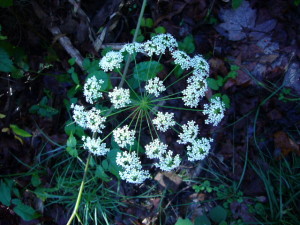
The blossom is an umbrella made up of smaller umbrellas.
An off-season surprise this week involved “the most deadly plant in North America.” Water Hemlock (Cicuta mexicana) is common locally. Commonly found in wet or damp locations, it’s usually seen in late spring and summer. Water Hemlock is rather easy to identify. The leaves have veins that terminate mostly between the teeth and the umbrella-shaped blossom is made up of smaller umbrellas. During a foraging class this past weekend we saw foot high water hemlock in a shady wet area. It’s not the the first time I have seen it in a season other than late spring or summer but it’s not that common in winter. This is a plant that can kill in just a couple of hours. To read more about water hemlock go here.
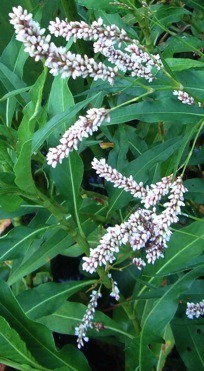
Smartweed.
Photo by Green Deane
Happily blossoming now is Smartweed, a hot pepper substitute. What makes the plant “hot” I do not know and have never found quality research on that. There are actually two sources of heat on the plant. The leaves have quite a bite. The blossoms are hot and bitter. The blossoms can be white or pink and the plant always grows in damp places if not in water. It likes ditches but they can be polluted so be careful One odd thing about the species is that it can also be used to catch fish. To read about Smartweed go here. I also have a video about Smartweed, filmed in the rain if I remember correctly. You can view it here.
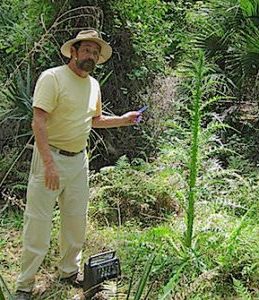
Foraging classes are held rain, shine, hot or cold. Photo by Nermina Krenata
Foraging Classes: See the world in a different way. This weekend I am bouncing around the southern part of the state, West Palm Beach Saturday, Port Charlotte Sunday:
Saturday, November 23rd, Dreher Park, 1200 Southern Blvd., West Palm Beach, 33405. 9 a.m. to noon. Meet in the parking lot just north of the science center.
Sunday, November 24th, Bayshore Live Oak Park, Bayshore Drive. Port Charlotte. 9 a.m. to noon. Meet at the parking lot at the intersection of Bayshore Road and Ganyard Street. 9 a.m. to noon.
Saturday November 30th, Boulware Springs Park, 3420 SE 15th St., Gainesville, FL 32641. 9 a.m. to noon. Meet at the picnic tables next to the pump house.
Sunday, December 1st, Mead Garden, 1500 S. Denning Dr., Winter Park, FL 32789. 9 a.m. to noon. Meet near the bathrooms.
Saturday, December 7th, Red Bug Slough Preserve, 5200 Beneva Road, Sarasota, FL, 34233. 9 a.m. to noon. Meet at the play ground.
To learn more about the classes, to sign up or to pre pay go here.
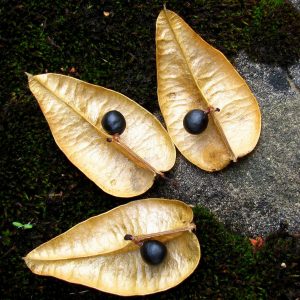
Golden Rain Tree seeds. I wonder if they are more edible when young and green?
The tree is easy to find but is it edible? The answer is yes, maybe, barely. It depends on which part you’re referring to. The problem is the more edible parts are around when you don’t notice the tree — spring time — and the least edible parts are around when you do notice it. Thus I never quite get around to knowing all that the Golden Rain tree has to offer. In the spring it has tender young shoots and leaves. They are edible after cooking. Don’t try them raw, they have a bit of cyanide in them. Months later in the fall the seeds are reported as a famine food, not exactly a glowing endorsement. In between the yellow flowers are used for a dye as is the bark. Those boiled leaves and shoots do have some antioxidant and anti-tumor capacity but the research is slow making it way out of arcane journals to common knolwedge. As for the seeds… they are kind of in the same position as the particular mustard seed which is used to make Canola Oil. They are edible but like unrefined Canola Oil they can be irritating. What I might try to do is collect some seeds, sprout them, boil them, and give them a try. You can read about the Golden Rain Tree here.
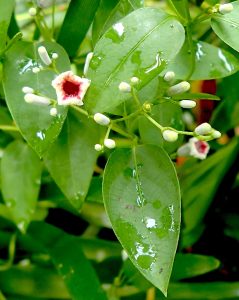
Skunk Vine lives up to its name. Photo by Green Deane
Perhaps as a last gasp — virtually — some Skunk Vine was blossoming this past week (along with some Black Cherries. See last week’s newsletter about out-of-seasoning blossoming.) Skunk Vine is aptly named though its aroma drifts more towards bathroom than skunk. However the tough vine is something of a nutritional powerhouse with some of the good chemicals one finds in the Brassica family. You can eat it raw but if you cook it outside is recommended. Oddly it was intentionally brought to Florida to make rope. This was done just before 1900 when a lot of ships were still carrying sails and miles of rope. Ground zero was the USDA Brooksville Field Station in Hernando County Fl. Yes, this invasive vine — like many other species — was imported by the United States Department of Agriculture. Thirty-six years later it was all over Florida but it took until 1977 for it to be a recognized invasive (long after it had crawled into other southern states.) While the blossoms are attractive we eat only the leaves and young tips. I have a video on Skunk Vine here and you can read about Skunk Vine here.
It’s a topic that concerns foragers: The fact that animals use the outdoors as their bathroom. There are some reasons for concern and some reasons not to be too concerned.

Jervey Gantt Dog Park, Ocala. Photo by Green Deane
I noticed some 60 years ago that wherever our dog Sister piddled on the lawn — what we had of it — the grass died. (She was called Sister because I didn’t have a sister.) The reason given for the grass death is a high urea content which is essentially a nitrogen overload. As a fertilizer a little dog piddle goes a long ways. Since we tend to not eat dead grass or the like it really isn’t a problem. Inside the home it’s the ammonia component that can irritate lungs and offend the nose. But outside most urine degrade fairly quickly and is not known for carrying a lot of long-lived bacteria. This is not so with other off-loaded material. Pets can be a source of varying diseases, bacterial to parasitical. Cat scat is among the most common domestically. Your feline’s deposits in your backyard can cause problems particularly to young children who are pretty close to the ground and what’s in it. Ditto dogs. And to be more specific it is the scat of primarily meat eaters that is more of a problem that other animals. Indeed, horse, cow and aged chicken manure was and in some places still are the fertilizers on many farms. Where I grew up slightly aged horse manure was favored for tomatoes. Cow manure was stronger and chicken manure was way to strong to use fresh. It would kill plants. Use some common sense: Don’t forage in a dog park.
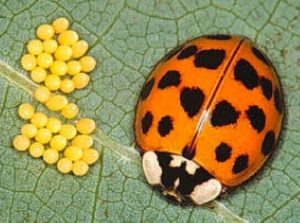
Ladybug and Eggs
While harmless to humans, masses of the multi-colored invaders are a deemed a nuisance when they slip in homes through cracks around doors and windows. They can also stain curtains, upholstery and walls if squashed. A spike in the ladybug population is typical this time of year as they fly out of the farm fields where they help control other insects and seek a warm place to spend the winter. In their native Asia — yes Ladybugs are not native — they usually overwinter in cliffs. The absence of cliffs attracts them to buildings. Mild winters followed by rainy springs can create the perfect environment for the species — the Multicolored Asian Lady Beetle — to flourish. Ladybugs are not edible but if you want to know about edible insects go here.
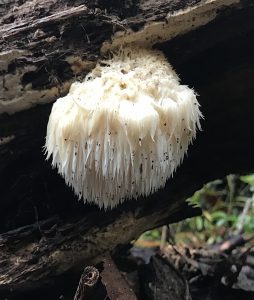
Lion’s Mane. See entry below. Photo by Green Deane
Want to identify a plant or mushroom? Perhaps you’re looking for a foraging reference? You might have a UFO, an Unidentified Flowering Object, you want identified. On the Green Deane Forum we — including Green Deane and others from around the world — chat about foraging all year. And it’s not just about warm-weather plants or just North American flora. Many nations share common weeds so there’s a lot to talk about, such as the one to the left. There’s also more than weeds. The reference section has information for foraging around the world. There are also articles on food preservation, and forgotten skills from making bows to fermenting food. Recent topics include: California Wild Mushroom Parties, A Good Reason To Eat Wild Garlic, Black Walnuts and Amaranth, Sea Salt and Plastic, Wild Mustard? Heavy Metals. Oriental Persimmons. What is it? Pine Cough Drops and Needles, Skullcap, Malodorous Plant? Another NJ Tree, Maypop? Roadside Plant, Unknown in Sudan, Please Help Identify, and Preserving Prickly Pear Bounty. You can join the forum by clicking on the button on the upper right hand side of this page. 
Donations to upgrade EatTheWeeds.com have gone well. Thank you to all who have contributed to either via the Go Fund Me link, the PayPal donation link or by writing to Green Deane POB 941793 Maitland FL, 32794. There are many needs left such as expanding the foraging teacher page, the page on monotypic edibles and the Plant Archive page. There’s always something and such things get more complex and expensive every year.
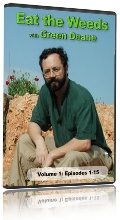 All of Green Deane’s videos are available for free on You Tube and make a good Christmas Gift to watch in the long winter months. They do have ads on them so every time you watch a Green Deane video I get a quarter of one cent. Four views, one cent. Not exactly a large money-maker but it helps pays for the newsletter. If you want to see the videos without ads and some in slightly better quality you can order the DVD set. It is nine DVDs with 15 videos on each. Many people want their own copy of the videos or they have a slow service and its easier to order then to watch them on-line. They make a good Christmas or birthday gift. Individual videos can also be ordered. You can order them by clicking on the button on the top right of this page or you can go here.
All of Green Deane’s videos are available for free on You Tube and make a good Christmas Gift to watch in the long winter months. They do have ads on them so every time you watch a Green Deane video I get a quarter of one cent. Four views, one cent. Not exactly a large money-maker but it helps pays for the newsletter. If you want to see the videos without ads and some in slightly better quality you can order the DVD set. It is nine DVDs with 15 videos on each. Many people want their own copy of the videos or they have a slow service and its easier to order then to watch them on-line. They make a good Christmas or birthday gift. Individual videos can also be ordered. You can order them by clicking on the button on the top right of this page or you can go here.
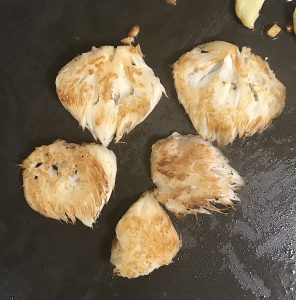
Fried Lion’s Mane. Photo by Green Deane
As the weather changes from warm and humid to cooler and dry one starts to look for edible fungi on trees, downed wood and buried roots. This time of year we start to see Chicken of the Woods, Oysters, Ringless Honey Mushrooms, and Lion’s Mane. The latter seems uncommon in Florida with sitings here and there. That’s unfortunate because Lion’s Mane is tasty, has a crabmeat-like texture, and is very easy to identify. I don’t see it often enough. There is a hint though: It will usually grow in the same area for years so if you do find it you can probably find it again next year about the same time and location. This tennis ball size example was seen during a foraging class in Jacksonville. We also harvested some Ringless Honey Mushrooms which you can read about here.
This is weekly newsletter 380. If you want to subscribe to this free newsletter you can find the sign-up form in the menu at the top of the page.
To donate to the Green Deane Newsletter click here.

